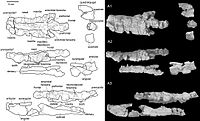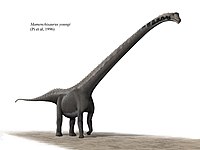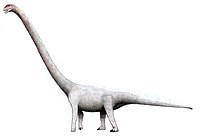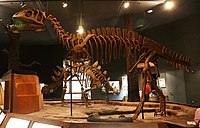| Shaximiao Formation | |
|---|---|
| Stratigraphic range: Middle Jurassic–Late Jurassic PreꞒ Ꞓ O S D C P T J K Pg N | |
 Excavation floor at the Zigong Dinosaur Museum Excavation floor at the Zigong Dinosaur Museum | |
| Type | Geological formation |
| Unit of | Chongqing Group |
| Sub-units | Lower, Upper Subunits |
| Underlies | Suining Formation |
| Overlies | Xintiangou Formation |
| Thickness | Lower Subunit: Up to 246.5 m (809 ft) Upper Subunit: 450–1,200 m (1,480–3,940 ft) |
| Lithology | |
| Primary | Sandstone |
| Other | Siltstone, mudstone |
| Location | |
| Coordinates | 29°12′N 105°54′E / 29.2°N 105.9°E / 29.2; 105.9 |
| Approximate paleocoordinates | 28°12′N 110°00′E / 28.2°N 110.0°E / 28.2; 110.0 |
| Region | Sichuan |
| Country | |
| Extent | Sichuan Basin |
  | |
The Shaximiao Formation (simplified Chinese: 沙溪庙组; traditional Chinese: 沙溪廟組 / 沙溪廟層; pinyin: Shāxīmiào zǔ) is a Middle to Late Jurassic aged geological formation in Sichuan, China, most notable for the wealth of dinosaurs fossils that have been excavated from its strata. The Shaximiao Formation is exposed in and around the small township of Dashanpu (simplified Chinese: 大山铺镇; traditional Chinese: 大山鋪鎮; pinyin: Dàshānpū zhèn), situated seven kilometres north-east from Sichuan's third largest city, Zigong, in the Da'an District.
Geology
The Shaximiao Formation includes two distinct subunits: The upper and lower Shaximiao Formations (simplified Chinese: 上·下沙溪庙地层; traditional Chinese: 上·下沙溪廟地層; pinyin: shàng / xià Shāxīmiào dìcéng), although they are commonly referred to as one, simply being called the "Shaximiao Formation". The upper Shaximiao Formation is also known as the Shangshaximiao Formation, and the lower Shaximiao Formation is also known as the Xiashaximiao Formation, which are direct transliterations of the Chinese names. Both subunits primarily consist of purple-red mudstones, with variable sand inclusion. and siltstones with interbedded sandstones.
Dinosaur finds

The Shaximiao Formation has produced mainly sauropods, but has also held numerous other dinosaur types, such as theropods and stegosaurians amongst others. In total, over 8,000 pieces of bone have been unearthed from the area – amounting to nearly 40 tonnes. The site was unknown until the early 1970s, when a Chinese gas company unearthed Gasosaurus in 1972. It would be the first of the many dinosaurs to be uncovered from the area. Most specimens found are held at the Zigong Dinosaur Museum which has been placed on the area during the mid-1980s.
Despite being a frequented "dinosaur-quarry" at present, the Shaximiao Formation was once a lush forest, evidence of which has been found alongside dinosaur remains in the form of fossilised wood. Paleontologists speculate that the area also had a lake that was fed by a large river. Dinosaur remains would have been swept toward the lake over millions of years, thus accounting for the hundreds of specimens found. Based on biostratigraphy, the Lower Shaximiao Formation has been usually seen to date to 168 to 161 million years old, between the Bathonian to Callovian stages of the Mid Jurassic, while the Upper Shaximiao was thought to be Oxfordian in age. A paper by Wang et al. (2018), (recalibrated dates reported in Moore et al. (2020)), reported a zircon U-Pb age of 160.4 ± 0.4 mya for the lower part of the Shaximiao Formation, suggesting that the Shaximiao Formation is younger than previously thought. Contradicting this, U-Pb dates from a tuff bed supports traditional Middle Jurassic age for the lower part of the formation, with an average age of around 166.0 ± 1.5 Ma. The top of the Shaximiao Formation has been believed to be the end of the Tithonian age.
Dong Zhiming's research
The paleontologist who has made the largest contribution to the formation and its excavation is Dong Zhiming. He first examined the formation in 1975, after bone fragments were found embedded in rock from the area. The site was being demolished to make way for both a natural gas field facility and a vehicle park when Dong first saw the area. Amongst the extensive clearings, Dong found numerous bone fragments which were exposed.
However, the specimens were being damaged due to bulldozers in the area and there would be little chance of closing the area as the state had invested millions of yuan in the site already. It was not until 1985 that the government finally agreed to close the construction on the site, and by then Dong and his team had already excavated over 100 dinosaurs from the area, including several rare sauropod skulls. A dinosaur found in the Shaximiao Formation, Dashanpusaurus dongi, was named in tribute of both Dashanpu and Dong Zhiming.
Paleobiota
In addition to dinosaur finds, many other prehistoric finds have been uncovered from the Shaximiao Formation. Amongst these finds are fishes, amphibians, turtles, marine reptiles such as crocodiles and also pterosaurs. Bienotheroides, a Tritylodont Synapsid has been found there, as well as Sinobrachyops, a Labyrinthodont.
Amphibians
| Genus | Species | Stratigraphic position | Material | Notes | Images |
|---|---|---|---|---|---|
| Sinobrachyops | S. placenticephalus | Shunosaurus-Omeisaurus assemblage, Lower Shaximiao Formation | A brachyolepid stereospondyl |
Fish
| Genus | Species | Stratigraphic position | Material | Notes | Images |
|---|---|---|---|---|---|
| Ceratodus | C. guanganensis | Mamenchisaurus assemblage, Upper Shaximiao Formation | A ceratodontid lungfish |
Sauropterygians
| Genus | Species | Stratigraphic position | Material | Notes | Images |
|---|---|---|---|---|---|
| Bishanopliosaurus | B. zigongensis | Shunosaurus-Omeisaurus assemblage, Lower Shaximiao Formation | A pliosauroid plesiosaur |
Crocodyliformes
| Genus | Species | Stratigraphic position | Material | Notes | Images |
|---|---|---|---|---|---|
| Sunosuchus | S. shunanensis | Shunosaurus-Omeisaurus assemblage, Lower Shaximiao Formation | A goniopholidid | 
| |
| Hsisosuchus | H. dashanpuensis | Shunosaurus-Omeisaurus assemblage, Lower Shaximiao Formation | A goniopholid | 
|
Pterosaurs
| Genus | Species | Stratigraphic position | Material | Notes | Images |
|---|---|---|---|---|---|
| Angustinaripterus | A. longicephalus | Shunosaurus-Omeisaurus assemblage, Lower Shaximiao Formation | A rhamphorhynchine rhamphorhynchid with a very elongated and flat snout and an estimated wingspan at 1.6 metres (5.2 ft) | 
|
Dinosaurs
Ornithischians
Neornithischians
Stegosaurs
| Genus | Species | Stratigraphic position | Material | Notes | Images |
|---|---|---|---|---|---|
| Bashanosaurus | B. primitivus | Lower Shaximiao Formation | The earliest-diverging stegosaur currently known; it shares features with basal thyreophorans and derived stegosaurs. |
 | |
|
C. kuani |
Mamenchisaurus assemblage, Upper Shaximiao Formation |
A stegosaurian. |
|||
|
C. jiangbeiensis |
Mamenchisaurus assemblage, Upper Shaximiao Formation |
A stegosaurian. |
|||
|
H. taibaii |
Shunosaurus-Omeisaurus assemblage, Lower Shaximiao Formation |
A huayangosaurid with more spike-like plates than Stegosaurus. It was also one of the smallest known stegosaurs, at just 4.5 meters (15 feet) in length. |
|||
|
G. sichuanensis |
Mamenchisaurus assemblage, Upper Shaximiao Formation |
A stegosaurian. |
 | ||
|
G. sp. |
Mamenchisaurus assemblage, Upper Shaximiao Formation |
A stegosaurian. | |||
|
T. multispinus |
Mamenchisaurus assemblage, Upper Shaximiao Formation |
A stegosaurian. |
|||
|
Y. jichuanensis |
Upper Shaximiao Formation |
Nearly complete skeleton |
A stegosaurian. |
 |
Sauropods
| Genus | Species | Stratigraphic position | Material | Notes | Images |
|---|---|---|---|---|---|
| Abrosaurus | A. dongpoi | Lower Shaximiao Formation | A macronarian known from a well-preserved skull and other elements. | 
| |
| Bashunosaurus | B. kaijiangensis | Lower Shaximiao Formation | An obscure possible macronarian | ||
|
D. zhangi |
Mamenchisaurus assemblage, Upper Shaximiao Formation |
||||
| Dashanpusaurus | D. dongi | Lower Shaximiao Formation | A basal macronarian | ||
|
D. bashanensis |
Shunosaurus-Omeisaurus assemblage, Lower Shaximiao Formation |
A mamenchisaurid. |
|||
|
M. constructus |
Mamenchisaurus assemblage, Upper Shaximiao Formation |
A mamenchisaurid. |
|||
|
M. hochuanensis |
Mamenchisaurus assemblage, Upper Shaximiao Formation |
A mamenchisaurid. |
|||
|
M. youngi |
Mamenchisaurus assemblage, Upper Shaximiao Formation |
A mamenchisaurid. |
|||
|
M. jingyanensis |
Mamenchisaurus assemblage, Upper Shaximiao Formation |
A mamenchisaurid. |
|||
|
O. luoquanensis |
Shunosaurus-Omeisaurus assemblage, Lower Shaximiao Formation |
||||
|
O. tianfuensis |
Shunosaurus-Omeisaurus assemblage, Lower Shaximiao Formation |
A mamenchisaurid. |
|||
|
O. junghsiensis |
Shunosaurus-Omeisaurus assemblage, Lower Shaximiao Formation |
A mamenchisaurid. |
|||
|
O. changshouensis |
Mamenchisaurus assemblage, Upper Shaximiao Formation |
A mamenchisaurid. |
|||
|
O. maoi |
Mamenchisaurus assemblage, Upper Shaximiao Formation |
A mamenchisaurid. |
|||
|
O. fuxiensis |
Mamenchisaurus assemblage, Upper Shaximiao Formation |
A mamenchisaurid. |
|||
|
P. oxyodon |
Shunosaurus-Omeisaurus assemblage, Lower Shaximiao Formation |
||||
|
S. lii |
Shunosaurus-Omeisaurus assemblage, Lower Shaximiao Formation |
A eusauropod estimated with a length at 9.5 meters (31 feet), the weight at 3 metric tons (3.3 short tons). The tail ended in a club, equipped on its top with two successive spikes formed by 5 centimetres (2.0 inches)-long cone-shaped osteoderms probably used to fend off enemies. | |||
| Yuzhoulong | Y. qurenensis | Lower Shaximiao Formation | A basal macronarian known from a subadult specimen | ||
|
Z. fuxiensis |
Mamenchisaurus assemblage, Upper Shaximiao Formation | Possibly a species of Mamenchisaurus. |
Theropods
| Genus | Species | Synonyms | Stratigraphic position | Material | Notes | Images |
|---|---|---|---|---|---|---|
|
C. ceratosauroides |
Mamenchisaurus assemblage, Upper Shaximiao Formation |
|||||
|
C. primitivus |
Shunosaurus-Omeisaurus assemblage, Lower Shaximiao Formation |
|||||
| Elaphrosaurinae indet. | Shunosaurus-Omeisaurus assemblage, Lower Shaximiao Formation | Formerly designated as the paratype of Chuandongocoelurus. | ||||
|
G. constructus |
Shunosaurus-Omeisaurus assemblage, Lower Shaximiao Formation |
An avetheropod that measured between 3.5 and 4 meters (11 and 13 ft) in length, with a weight of around 150 kilograms (330 pounds). However, some estimates put its weight as high as 400 kilograms (880 pounds), as very little is known about it. | ||||
|
K. lini |
Shunosaurus-Omeisaurus assemblage, Lower Shaximiao Formation |
A megalosaurid, early tetanuran, early averostran or basal carnosaur. |
||||
|
L. qianweiensis |
Shunosaurus-Omeisaurus assemblage, Lower Shaximiao formation |
A megalosaurid. |
||||
|
S. fragilis |
Mamenchisaurus assemblage, Upper Shaximiao Formation |
|||||
| Sinraptor |
S. hepingensis |
Mamenchisaurus assemblage, Upper Shaximiao Formation |
Probably represents a new genus. |
|||
|
S. campi |
Mamenchisaurus assemblage, Upper Shaximiao Formation |
A metriacanthosaurid. Remains from the Shaximiao Formation might represent an indeterminate theropod. |
||||
|
X. qilixiaensis |
Shunosaurus-Omeisaurus assemblage, Lower Shaximiao Formation |
A metriacanthosaurid. |
||||
|
Y. shangyouensis |
|
Mamenchisaurus assemblage, Upper Shaximiao formation |
A metriacanthosaurid | |||
|
Y. zigongensis |
|
Shunosaurus-Omeisaurus assemblage, Lower Shaximiao Formation |
ZDM 9011 (holotype), a partial postcranial skeleton; ZDM 9012, a left maxilla; ZDM 9013, two teeth and ZDM 9014, a right hind limb. |
Turtles
| Genus | Species | Stratigraphic position | Material | Notes | Images |
|---|---|---|---|---|---|
|
C. baenoides |
Shangshaximiao Formation |
||||
|
C. dashanpuensis |
Shangshaximiao Formation |
A xinjiangchelyid. |
|||
|
C. latimarginalis |
Shunosaurus-Omeisaurus assemblage, Lower Shaximiao Formation |
A xinjiangchelyid. |
|||
|
S. chowi |
Shunosaurus-Omeisaurus assemblage, Lower Shaximiao Formation |
||||
|
T. zigongensis |
Shangshaximiao Formation |
A xinjiangchelyid. |
|||
|
S. wimani |
Shangshaximiao Formation |
A trionychian, possibly the oldest known cryptodire |
Therapsids
| Genus | Species | Stratigraphic position | Material | Notes | Images |
|---|---|---|---|---|---|
|
B. zigongensis |
Shunosaurus-Omeisaurus assemblage, Lower Shaximiao Formation |
||||
|
P. chuannanensis |
Shunosaurus-Omeisaurus assemblage, Lower Shaximiao Formation |
A tritylodontid. |
|||
|
Tritylodontidae |
gen. et sp. indet. |
Shunosaurus-Omeisaurus assemblage, Lower Shaximiao Formation |
An indeterminate tritylodontid. |
Plants
| Genus | Species | Stratigraphic position | Material | Notes |
|---|---|---|---|---|
| Brachyoxylon | B. qijiangense | Masangyan village | Leaves | Family unknown. |
See also
References
- "Dinosaur diplomacy: What you need to know about China's 'renewed emphasis' on fossil research". CNA. Retrieved 10 December 2024.
- Wang, Jun; Ye, Yong; Pei, Rui; Tian, Yamin; Feng, Chongqin; Zheng, Daran; Chang, Su-Chin (2018-04-03). "Age of Jurassic basal sauropods in Sichuan, China: A reappraisal of basal sauropod evolution". GSA Bulletin. 130 (9–10): 1493–1500. Bibcode:2018GSAB..130.1493W. doi:10.1130/B31910.1. ISSN 0016-7606.
- ^ Moore, Andrew J.; Upchurch, Paul; Barrett, Paul M.; Clark, James M.; Xing, Xu (2020-08-17). "Osteology of Klamelisaurus gobiensis (Dinosauria, Eusauropoda) and the evolutionary history of Middle–Late Jurassic Chinese sauropods" (PDF). Journal of Systematic Palaeontology. 18 (16): 1299–1393. Bibcode:2020JSPal..18.1299M. doi:10.1080/14772019.2020.1759706. ISSN 1477-2019. S2CID 219749618.
- Zhou, Yuxuan; Dai, Hui; Yu, Haidong; Ma, Qingyu; Tan, Chao; Li, Ning; Lin, Yu; Li, Deliang (2022-04-15). "Zircon geochronology of the new dinosaur fauna in the Middle Jurassic lower Shaximiao Formation in Chongqing, SW China". Palaeogeography, Palaeoclimatology, Palaeoecology. 592: 110894. Bibcode:2022PPP...59210894Z. doi:10.1016/j.palaeo.2022.110894. ISSN 0031-0182. S2CID 247000432.
- ^ Li, K; Liu, J.; Yang, C.; Hu, F. (2011). "Dinosaur assemblages from the Middle Jurassic Shaximiao Formation and Chuanjie Formation in the Sichuan-Yunnan Basin, China". Volumina Jurassica. 9 (9): 21–42.
- 董枝明. "四川自贡大山铺蜀龙动物群——简报 V 两栖类." 古脊椎动物学报 4 (1985): 008
- Wang, Z.; Jiang, X.; Wang, X.; Gao, J.; Zhu, S. (2022). "Tooth Plates of Ceratodus (Dipnoi, Ceratodontidae) from the Upper Jurassic Shaximiao Formation of Guang'an, Sichuan Province, China". Acta Geologica Sinica (English Edition). 96 (3): 766–775. Bibcode:2022AcGlS..96..766W. doi:10.1111/1755-6724.14774. S2CID 237853795.
- Dong, Z.-M. "A new plesiosauria from the Lias of Sichuan Basin" (PDF). Vertebrata PalAsiatica. 18 (3): 191–197. Archived from the original (PDF) on 2012-03-01. Retrieved 2010-02-21.
- Hui, Dai; Ning, Li; Maidment, Susannah C. R.; Guangbiao, Wei; Yuxuan, Zhou; Xufeng, Hu; Qingyu, Ma; Xunqian, Wang; Haiqian, Hu; Guangzhao, Peng (2022-03-03). "New Stegosaurs from the Middle Jurassic Lower Member of the Shaximiao Formation of Chongqing, China". Journal of Vertebrate Paleontology. 41 (5): e1995737. doi:10.1080/02724634.2021.1995737. ISSN 0272-4634. S2CID 247267743.
- ^ Zhu, S. (1994). "记四川盆地营山县一剑龙化石" [Record of a fossil stegosaur from Yingshan in the Sichuan Basin]. Sichuan Cultural Relics (S1): 8–14.
- ^ Dai H, Tan C, Xiong C, Ma Q, Li N, Yu H, Wei Z, Wang P, Yi J, Wei G, You H, Ren X (2022). "New macronarian from the Middle Jurassic of Chongqing, China: phylogenetic and biogeographic implications for neosauropod dinosaur evolution". Royal Society Open Science. 9 (11). 220794. Bibcode:2022RSOS....920794D. doi:10.1098/rsos.220794. PMC 9627447. PMID 36340515.
- ^ Carrano, M. T.; Benson, R. B. J.; Sampson, S. D. (2012). "The phylogeny of Tetanurae (Dinosauria: Theropoda)". Journal of Systematic Palaeontology. 10 (2): 211–300. Bibcode:2012JSPal..10..211C. doi:10.1080/14772019.2011.630927. S2CID 85354215.
- Joyce, W. G.; Rabi, M.; Clark, J. M.; Xu, Xing (2016). "A toothed turtle from the Late Jurassic of China and the global biogeographic history of turtles". BMC Evolutionary Biology. 16 (1): 236. Bibcode:2016BMCEE..16..236J. doi:10.1186/s12862-016-0762-5. PMC 5084352. PMID 27793089.
- Ouyang, Hui; Li, Lu; Tong, Haiyan (July 2014). "A revision of Sinaspideretes wimani Young & Chow, 1953 (Testudines: Cryptodira: Trionychoidae) from the Jurassic of the Sichuan Basin, China". Geological Magazine. 151 (4): 600–610. Bibcode:2014GeoM..151..600T. doi:10.1017/S0016756813000575. ISSN 0016-7568. S2CID 128423062.
- Xie, Aowei; Wang, Yongdong; Tian, Ning; Uhl, Dieter (10 July 2023). "A new extinct conifer Brachyoxylon from the Middle Jurassic in southern China: Wood anatomy, leaf phenology, and paleoclimate". Review of Palaeobotany and Palynology. 317: 104945. Bibcode:2023RPaPa.31704945X. doi:10.1016/j.revpalbo.2023.104945.





















